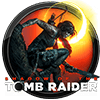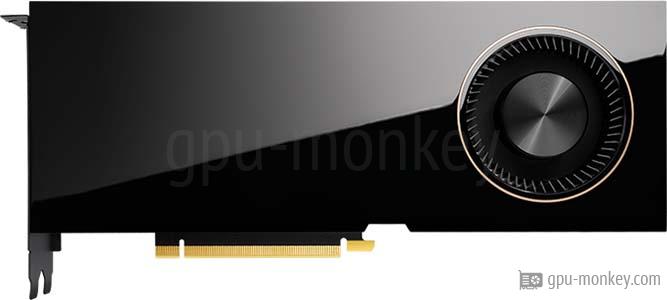
PNY RTX A6000
Benchmark and Specs
Last updated:
Benchmark and Specs
Here we show you benchmarks and technical data for the PNY RTX A6000. The graphics card is based on the NVIDIA RTX A6000 (Ampere) and has 48 GB GDDR6 graphics memory with a memory bandwidth of 768 GB/s. The PNY RTX A6000 has 84 execution units with 10752 shaders.
GPUThe PNY RTX A6000 has 10752 shaders and 84 execution units. The graphics card thus achieves a theoretical FP32 computing power of 38.71 TFLOPS. |
|
| Based on: | NVIDIA RTX A6000 |
| GPU Chip: | GA102 (Ampere) |
| Streaming Multiprocessors: | 84 |
| Shader: | 10752 |
| Render Output Units: | 112 |
| Texture Units: | 336 |
| Raytracing Cores: | 84 |
MemoryThe PNY RTX A6000 can use 48 GB graphics memory of the type GDDR6. The graphics card thus achieves a memory bandwidth of 768 GB/s on a 384 bit wide memory interface. |
|
| Memory Size: | 48 GB |
| Memory Type: | GDDR6 |
| Memory Clock: | 2.000 GHz |
| Memory Speed: | 16.0 Gbps |
| Memory bandwidth: | 768 GB/s |
| Memory Interface: | 384 bit |
Clock SpeedsThe base clock frequency of the PNY RTX A6000 is 1.410 GHz. A high clock frequency (even in turbo mode) can greatly increase the speed of a graphics card. |
|
| Base Clock: | 1.410 GHz |
| Boost Clock: | 1.800 GHz |
| Avg (Game) Clock: | |
| Overclocking: | Yes |
Thermal DesignThe TDP (Thermal Design Power) of the PNY RTX A6000 is 300 W. The graphics card is supplied with energy via the 1 x 8-Pin connector. |
|
| TDP: | 300 W |
| TDP (up): | -- |
| Tjunction max: | 93 °C |
| PCIe-Power: | 1 x 8-Pin |
Cooler & FansThe PNY RTX A6000 has a total of 1 Radial fans to cool the graphics processor and graphics memory. |
|
| Fan-Type: | Radial |
| Fan 1: | 1 x 65 mm |
| Fan 2: | -- |
| Cooler-Type: | Air cooling |
| Noise (Idle): | -- |
| Noise (Load): | -- |
ConnectivityUp to 4 screens can be connected to the PNY RTX A6000. |
|
| Max. Displays: | 4 |
| HDCP-Version: | 2.3 |
| HDMI Ports: | -- |
| DP Ports: | 4x DP v1.4 |
| DVI Ports: | -- |
| VGA Ports: | -- |
| USB-C Ports: | -- |
FeaturesetThe PNY RTX A6000 has a maximum resolution of 7680x4320 pixels. The graphics card supports the DirectX 12_2 (Ultimate) standard. |
|
| Max. resolution: | 7680x4320 |
| DirectX: | 12_2 (Ultimate) |
| Raytracing: | Yes |
| DLSS / FSR: | Yes |
| LED: | No LED lighting |
Supported Video CodecsThe video codecs accelerated in hardware by the PNY RTX A6000 reduce the processor load and ensure lower energy consumption. |
|
| h264: | Decode / Encode |
| h265 / HEVC: | Decode / Encode |
| VP8: | Decode |
| VP9: | Decode |
| AV1: | Decode |
DimensionsThe PNY RTX A6000 is 267 mm long and 112 mm high. With a width of --, the graphics card requires 2 PCIe-Slots in the case. |
|
| Length: | 267 mm |
| Height: | 112 mm |
| Width: | -- |
| Width (Slots): | 2 PCIe-Slots |
| Weight: | -- |
Additional dataThe PNY RTX A6000 made in 8 nm was published in Q4/2020 for 4,649 $. |
|
| GPU Interface: | PCIe 4.0 x 16 |
| Release date: | Q4/2020 |
| Launch Price: | 4,649 $ |
| Structure size: | 8 nm |
| Part-no: | VCNRTXA6000-PB |
| Documents: | data sheet |
Rate this graphics card
Benchmark results
3DMark Benchmark (DirectX, Raytracing)
3DMark is a benchmark program that determines the performance of certain components of a computer and then reports the performance as a numerical value.
Time Spy Extreme Graphics score

|
PNY RTX A6000
48 GB GDDR6 |
||

|
NVIDIA RTX A6000
Average of gpu group |
||
Port Royal (Raytracing)

|
PNY RTX A6000
48 GB GDDR6 |
||

|
NVIDIA RTX A6000
Average of gpu group |
||
Speed Way Graphics Score (Raytracing)

|
PNY RTX A6000
48 GB GDDR6 |
||

|
NVIDIA RTX A6000
Average of gpu group |
||
Battlefield 5
Battlefield 5 is a visually stunning game that is ideal as a graphics card benchmark. We test the game with maximum details on Windows 10.
1920x1080 (1080p)

|
PNY RTX A6000
48 GB GDDR6 |
||

|
NVIDIA RTX A6000
Average of gpu group |
||
Geekbench 6 (OpenCL, Vulkan, Metal)
Geekbench 6 is a cross-platform benchmark for main processors, which also carries out 3 different graphics benchmarks and outputs them in the form of a numerical value.
Geekbench 6 - OpenCL

|
PNY RTX A6000
48 GB GDDR6 |
||

|
NVIDIA RTX A6000
Average of gpu group |
||
Geekbench 6 - Vulkan

|
PNY RTX A6000
48 GB GDDR6 |
||

|
NVIDIA RTX A6000
Average of gpu group |
||
FP32 Performance (Single-precision TFLOPS)
The theoretical computing power of the graphics card with single precision (32 bit) in TFLOPS indicates how many trillion FP32 floating point operations the graphics card (GPU) can perform per second.
FP32 (TFLOPS)

|
PNY RTX A6000
48 GB GDDR6 |
||
More benchmarks
In order to determine the performance of a graphics card, so-called "benchmarks" are carried out. The benchmark software carries out special calculations to determine the performance of a graphics card. We use so-called theoretical or synthetic benchmarks (e.g. 3D Mark) as well as real game benchmarks. To ensure real comparability of the results, we pay attention to the correct execution of the benchmarks as well as the condition of the graphics card and the system.We use the following benchmarks to measure the performance of a graphics card:

3DMark Benchmark
5,159 entries
5,159 entries

GTA 5 Benchmark
4,624 entries
4,624 entries

Shadow of the Tomb Raider
5,148 entries
5,148 entries

Battlefield 5
4,510 entries
4,510 entries

Geekbench 6
5,151 entries
5,151 entries

Crypto-Mining Ethereum Hashrate
3,506 entries
3,506 entries

FP32 Performance
5,522 entries
5,522 entries
Popular comparisons







